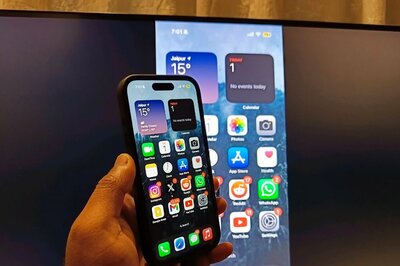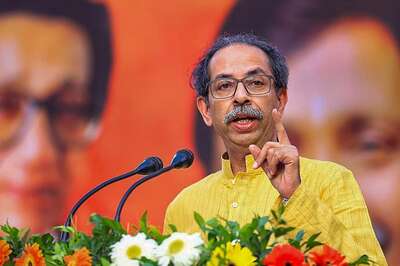Is Omicron More Dangerous than Delta, Will Vaccines Work? India’s Leading Expert on Covid-19 Answers

views
Why is the new COVID-19 variant B.1.1.529 called Omicron?
The SARS-CoV-2 variants have their standard scientific names and classifications based on Pango (Phylogenetic Assignment of Named Global Outbreak) lineage and Nextstrain clade. However, to ensure that the countries where these variants are first reported are not unduly stigmatised and for the ease of reference by the general public, May 2021 onwards, the World Health Organisation (WHO) has started providing labels (or popular names) to SARS-CoV-2 variants based on Greek alphabets. In naming the new variant B.1.1.529, two Greek letters have been skipped. ‘Nu’ was not used as it was considered that people may confuse it with ‘New’. The next letter ‘Xi’ was not used as it could have been associated with a specific country. It was named after the next alphabet—Omicron.
There are 24 letters in the Greek alphabet with the first being Alpha and the last Omega. Omicron is the 15th Greek alphabet. Next SARS-CoV-2 variant, as and when reported, is likely to be named Pi.
Is Omicron variant considered more dangerous than the Delta variant? Why?
What we know about B.1.1.529 or Omicron is that it has around 50 mutations, of which 32 are in spike proteins and 10 of those mutations are of a high relevance. These include H655Y, N679K and P681H mutations, which potentially increase the transmissibility. The mutations R203K and G204R are considered to be associated with higher infectivity. Similarly, there is missing gene for membrane protein, nsp6, which could result in immune escape. The mutations in N-terminal and Furin cleavage sites in spike protein may affect the immune protection as these sections bind to antibodies. The mutation in receptor binding domains helps the virus to latch onto the cell and increase transmissibility.
These are some, amongst other, factors which give scientific plausibility to change in transmissibility, infectivity, clinical features and immune escape. However, it is not necessary that a few mutations in combination would have the same effect, if reported in isolation. Considering that clinical features appear after a delay, it could take 3 to 4 weeks or even longer to understand the impact.
Delta, at least till now, has higher transmissibility than all existing variants and we don’t know how much difference Delta and Omicron may have in transmissibility. The real impact of Omicron will depend on what are the final characteristics and properties and which combination it has. For instance, a more transmissible variant with no immune escape may not have any impact on populations with high vaccine coverage. However, it may fuel a fresh wave in a population with low vaccine coverage. Some modelling studies should be done to understand the impact of the variant in various scenarios.
How high is the risk of re-infection with respect to the Omicron?
Scientific studies are in progress to determine how individual immunity (natural and vaccine-induced) performs against the new variant. We need to remember that there is always a possibility of re-infection in everyone, with an existing variant or a new variant. The immunity helps in reducing the progression to clinical disease. To prevent infection from existing variants as well as Omicron, we need to continue to follow the same COVID-appropriate behaviours.
Will vaccines be effective against this new variant or is there a need to get a booster shot?
We need to remember that vaccines are effective but do not offer 100 per cent protection. There are breakthrough infections with all vaccines and even with existing variants, including the Delta variant. It is yet to be seen whether the rate of breakthrough infections would be similar, lower or higher with Omicron.
The assumption of immune escape is also theoretical—that there are mutations in sections of spike proteins which bind to vaccine-induced antibodies and may reduce effectiveness of vaccines. Scientists in many countries have started laboratory studies on neutralising antibodies against this variant and findings would be available in the coming days. Data on real-world effectiveness will take longer. In any case, while the need for more neutralising antibodies against the variant or a reduction in vaccine effectiveness is a possibility, as has been with other variants, there is every reason to believe that vaccines are still going to work.
How big a cause of concern is the Omicron variant for the world and India?
Any emergence of a variant should be treated with utmost alert and caution, but not with panic. We also need to learn from the past. The Beta variant (B.1.351), first reported in South Africa, had immune escape ability and was finally (so far) reported by 100-plus countries. Yet, it never became a major concern in any country. Similarly, Lambda (C.1.37) was a major variant in the Americas but not in other parts. We need to have more data to understand the full impact of Omicron and that may take around 3 to 4 weeks or even longer.
In India, there has been some complacency at all fronts—be it lack of COVID-appropriate behaviour or hesitancy to take first and second shots of vaccines. This is the time to shake off fatigue and complacency. It is time for all Indian states to review the preparedness and response. The promises made by governments on strengthening of health systems should be implemented, in an accelerated manner.
It is difficult to predict how the new variant will unfold in India or in any other setting; however, staying vigilant and conducting scientific and epidemiological studies are important in any setting. The SoP remains the same. Even if one case of Omicron is reported, it might not mean any new intervention overnight but scaling up the response system.
Is a travel ban or restricting flights from countries reporting Omicron the right strategy?
There is limited value, if at all, in travel or flight restrictions from affected countries. There are a number of reasons for that. One, by the time a variant is identified, it might have already been circulated to many other settings or may have entered other countries. Second, a ban from countries which have reported Omicron may not stop transmission from people coming from other settings where a new variant is present but not reported. Third, it may give a false sense of security.
Most importantly, travel bans or flight restrictions disincentivise the countries which are doing honest and timely reporting. It may work as a deterrent for other nations to report cases. Therefore, the prudent approach is to continue the flights but exercise stringent measures to detect infection, track cases, trace contact, and ensure strict adherence to quarantine and isolation rules.
What are the immediate preventive steps we should take to prepare better for this new variant?
The silver lining is that in the last 21 months, we have developed a better understanding of SARS-CoV-2 and the preventive measures that work against it. Face masks, physical distancing, improved ventilation and vaccination are the four powerful tools. These should be used by everyone to protect themselves and prevent the spread of the virus.
Although daily new cases in India are low and Omicron has not been reported here, people need to keep following COVID-appropriate behaviour in public places. Ventilation of closed spaces needs to be reviewed and improved upon. People who have not taken the first shot of the COVID-19 vaccine and those due for the second shot should get it at the earliest.
For state governments, preparedness is important. Genomic sequencing needs to be enhanced and testing at the port of entry needs to be calibrated and targeted. India’s response should be graded and proportionate to the challenge at the local level; it should not be an overreaction. It has to be dynamic and as and when new information becomes available, the approach should be suitably revised.
Dr Chandrakant Lahariya (MBBS, MD), Physician-Epidemiologist, is India’s leading expert on COVID-19 disease and vaccines. The views expressed in this article are those of the author and do not represent the stand of this publication.
Read all the Latest Opinions here




















Comments
0 comment